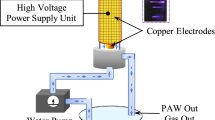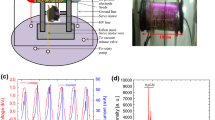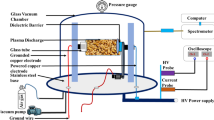Abstract
The study deals with the effect of low pressure dielectric barrier discharge (LPDBD) plasma and plasma activated water (PAW) produced with Ar, O2 and Air on germination and growth in rapeseed. Although H2O2 concentration showed no significant changes, α‑amylase activity (germination inducer) significantly increased in seeds due to LPDBD plasma. In addition, the activity of SOD and CAT was significantly induced in seeds of rapeseed treated with PAW. Rapeseed plants grown from the LPDBD plasma treated seeds showed significant improvements in shoot characteristics, chlorophyll synthesis, total soluble protein and sugar concentration compared to controls. Interestingly, plasma treated plants also showed no significant variations of H2O2 in tissue(s) which is supported by the biochemical and molecular evidence(s) of antioxidant enzymes. Plants exhibited a significant increase in tissue APX and CAT activities along with BnAPX and BnCAT expression(s) in roots when seeds were treated with LPDBD Air/O2 and PAW O2. This suggests that LPDBD plasma might have been involved with elevated level of reactive oxygen species, which was tightly controlled through the upregulation of APX and CAT activities and thus trigger the growth and development in rapeseed plants. These findings reveal the role and mechanisms of LPDBD technique facilitating germination and growth in rapeseed plants.
Zusammenfassung
Die Studie beschäftigt sich mit der Wirkung von Niederdruckplasma mit dielektrischer Barriereentladung (engl. low pressure dielectric barrier discharge plasma, LPDBD plasma) und plasmaaktiviertem Wasser (PAW), die mit Ar, O2 und Luft hergestellt werden, auf die Keimung und das Wachstum von Raps. Obwohl die H2O2-Konzentration keine signifikanten Veränderungen zeigte, stieg die α‑Amylase-Aktivität (Keimungsinduktor) im Saatgut durch das LPDBD-Plasma signifikant an. Darüber hinaus wurde die Aktivität von SOD und CAT in Rapssamen, die mit PAW behandelt wurden, signifikant induziert. Rapspflanzen aus dem mit LPDBD-Plasma behandelten Saatgut zeigten signifikante Verbesserungen der Sprosseigenschaften, der Chlorophyllsynthese, der Gesamtprotein- und Zuckerkonzentration im Vergleich zur Kontrolle. Interessanterweise zeigten plasmabehandelte Pflanzen auch keine signifikanten Variationen von H2O2 in Gewebe(n), was durch die biochemischen und molekularen Nachweise von antioxidativen Enzymen bestätigt wird. Pflanzen zeigten einen signifikanten Anstieg der Gewebe-APX- und CAT-Aktivitäten sowie der BnAPX- und BnCAT-Expression(en) in den Wurzeln, wenn Samen mit LPDBD Luft/O2 und PAW O2 behandelt wurden. Dies deutet darauf hin, dass LPDBD-Plasma an einem erhöhten Level an reaktiven Sauerstoffspezies beteiligt gewesen sein könnte, was durch die Hochregulierung der APX- und CAT-Aktivitäten streng kontrolliert wurde und somit das Wachstum und die Entwicklung von Rapspflanzen auslöste. Diese Ergebnisse tragen zum Verständnis der Rolle und der Mechanismen der LPDBD-Technik bei. Durch den Einsatz dieser Technik können die Keimung und das Wachstum von Rapspflanzen verbessert werden.






Similar content being viewed by others
References
Alexieva V, Sergiev I, Mapelli S, Karanov E (2001) The effect of drought and ultraviolet radiation on growth and stress markers in pea and wheat Plant. Plant Cell Environ 24:1337–1344
Almeselmani M, Deshmukh P, Sairam R, Kushwaha S, Singh T (2006) Protective role of antioxidant enzymes under high temperature stress Plant. Science 171:382–388
Bailly C, El-Maarouf-Bouteau H, Corbineau F (2008) From intracellular signaling networks to cell death: the dual role of reactive oxygen species in seed physiology. C R Biol 331:806–814
Beck E, Ziegler P (1989) Biosynthesis and degradation of starch in higher plants Annual review of plant. Biology (Basel) 40:95–117
Du CM, Wang J, Zhang L, Li HX, Liu H, Xiong Y (2012) The application of a non-thermal plasma generated by gas–liquid gliding arc discharge in sterilization. New J Phys 14:13010
Dubois M, Gilles KA, Hamilton JK, Rebers PA, Smith F (1956) Colorimetric method for determination of sugars and related substances. Anal Chem 28:350–356
Goud PB, Kachole MS (2012) Antioxidant enzyme changes in neem, pigeonpea and mulberry leaves in two stages of maturity. Plant Signal Behav 7:1258–1262
Guo Q, Wang Y, Zhang H, Qu G, Wang T, Sun Q, Liang D (2017) Alleviation of adverse effects of drought stress on wheat seed germination using atmospheric dielectric barrier discharge plasma treatment. Sci Rep 7:16680
Guy C, Haskell D, Neven L, Klein P, Smelser C (1992) Hydration-state-responsive proteins link cold and drought stress in spinach. Planta 188:265–270
Hoagland DR, Arnon DI (1950) The water-culture method for growing plants without soil Circular. California agricultural experiment station 347
Jeevan Kumar S, Rajendra Prasad S, Banerjee R, Thammineni C (2015) Seed birth to death: dual functions of reactive oxygen species in seed physiology. Ann Bot 116:663–668
Junior CA, de Oliveira Vitoriano J, Da Silva DLS, de Lima Farias M, de Lima Dantas NB (2016) Water uptake mechanism and germination of Erythrina velutina seeds treated with atmospheric plasma. Sci Rep 6:33722
Kaneko M, Itoh H, Ueguchi-Tanaka M, Ashikari M, Matsuoka M (2002) The α‑amylase induction in endosperm during rice seed germination is caused by gibberellin synthesized in epithelium. Plant Physiol 128:1264–1270
Kranner I, Roach T, Beckett RP, Whitaker C, Minibayeva FV (2010) Extracellular production of reactive oxygen species during seed germination and early seedling growth in Pisum sativum. J Plant Physiol 167:805–811
Li W, Liu X, Khan MA, Yamaguchi S (2005) The effect of plant growth regulators, nitric oxide, nitrate, nitrite and light on the germination of dimorphic seeds of Suaeda salsa under saline conditions. J Plant Res 118:207–214
Lichtenthaler HK, Wellburn AR (1983) Determinations of total carotenoids and chlorophylls a and b of leaf extracts in different solvents. Biochemical Society Transactions 11:591–592
Ling L, Jiafeng J, Jiangang L, Minchong S, Xin H, Hanliang S, Yuanhua D (2014) Effects of cold plasma treatment on seed germination and seedling growth of soybean. Sci Rep 4:5859
Malar S, Vikram SS, Favas PJ, Perumal V (2016) Lead heavy metal toxicity induced changes on growth and antioxidative enzymes level in water hyacinths [Eichhornia crassipes (Mart.)]. Bot Stud 55:54
Meiqiang Y, Mingjing H, Buzhou M, Tengcai M (2005) Stimulating effects of seed treatment by magnetized plasma on tomato growth and yield Plasma. Sci Technol 7:3143
Meng Y, Qu G, Wang T, Sun Q, Liang D, Hu S (2017) Enhancement of germination and seedling growth of wheat seed using dielectric barrier discharge plasma with various gas sources. Plasma Chem Plasma Process 37:1105–1119
Mitra A, Li Y‑F, Klämpfl TG, Shimizu T, Jeon J, Morfill GE, Zimmermann JL (2014) Inactivation of surface-borne microorganisms and increased germination of seed specimen by cold atmospheric plasma. Food Bioproc Tech 7:645–653
Noctor G et al (2012) Glutathione in plants: an integrated overview. Plant Cell Environ 35:454–484
Park G et al (2012) Atmospheric-pressure plasma sources for biomedical applications. Plasma Sources Sci Technol 21:43001
Rahman MM, Sajib SA, Rahi MS, Tahura S, Roy NC, Parvez S, Reza MA, Talukder MR, Kabir AH (2018) Mechanisms and signaling associated with LPDBD plasma mediated growth improvement in wheat. Scientific Reports 8(1)
Roy N, Hasan M, Talukder M, Hossain M, Chowdhury A (2018) Prospective applications of low frequency glow discharge plasmas on enhanced germination, growth and yield of wheat. Plasma Chem Plasma Process 38:13–28
Sarinont T, Katayama R, Wada Y, Koga K, Shiratani M (2017) Plant growth enhancement of seeds immersed in plasma activated water. MRS Adv 2:995–1000
Šerá B, Šerý M, Štrañák V, Špatenka P (2009) Does cold plasma affect breaking dormancy and seed germination? a study on seeds of Lamb’s quarters (Chenopodium album agg.). Plasma Sci Technol 11:750
Sera B, Spatenka P, Sery M, Vrchotová N, Hruskova I (2010) Influence of plasma treatment on wheat and oat germination and early growth. IEEE Trans Plasma Sci 38:2963–2968
Sivachandiran L, Khacef A (2017) Enhanced seed germination and plant growth by atmospheric pressure cold air plasma: combined effect of seed and water treatment. RSC Adv 7:1822–1832
Sreethawong T, Thakonpatthanakun P, Chavadej S (2007) Partial oxidation of methane with air for synthesis gas production in a multistage gliding arc discharge system. Int J Hydrogen Energy 32:1067–1079
Sun M, Zigman S (1978) An improved spectrophotometric assay for superoxide dismutase based on epinephrine autoxidation. Anal Biochem 90:81–89
Valencia A, Bustillo AE, Ossa GE, Chrispeels MJ (2000) α‑Amylases of the coffee berry borer (Hypothenemus hampei) and their inhibition by two plant amylase inhibitors. Insect Biochem Mol Biol 30:207–213
Volin JC, Denes FS, Young RA, Park SM (2000) Modification of seed germination performance through cold plasma chemistry technology. Crop Sci 40:1706–1718
Wojtyla Ł, Lechowska K, Kubala S, Garnczarska M (2016) Different modes of hydrogen peroxide action during seed germination. Front Plant Sci 7:66
Yu L, Li X, Tu X, Wang Y, Lu S, Yan J (2009) Decomposition of naphthalene by dc gliding arc gas discharge. J Phys Chem A 114:360–368
Zhao C et al (2016) Field warming experiments shed light on the wheat yield response to temperature in China. Nat Commun 7:13530
Zhou Z, Huang Y, Yang S, Chen W (2011) Introduction of a new atmospheric pressure plasma device and application on tomato seeds. Agric Sci 2:23–27
Acknowledgements
We are grateful to Bioresearch Technologies, Denmark, for supplying primers.
Author information
Authors and Affiliations
Corresponding author
Ethics declarations
Conflict of interest
S. Islam, F.B. Omar, S.A. Sajib, N.C. Roy, A. Reza, M. Hasan, M.R. Talukder and A.H. Kabir declare that they have no competing interests.
Caption Electronic Supplementary Material
Supplementary Fig. S1. a
Schematic diagram of LPDBD plasma for rapeseed treatment with Ar/O2 and Ar/Air gases, b V-I waveform of Ar/Air LPDBD plasma measured at applied voltage 3 kV and electrode spacing 30 mm and c emitted spectrum from Air/O2 and Ar/Air LPDBD plasmas at applied voltage \(3kV\) and electrode spacing 30 mm.
Supplementary Fig. S2. a
Schematic diagram for the generation of PAW with Ar and O2, b V-I waveform of H2O/Ar Arc measured at applied voltage 3 kV and electrode spacing 15 mm and c emitted spectrum from H2O/O2 and H2O/Ar Arc discharge plasmas at applied voltage 3 kV and electrode spacing 15 mm.
Rights and permissions
About this article
Cite this article
Islam, S., Omar, F.B., Sajib, S.A. et al. Effects of LPDBD Plasma and Plasma Activated Water on Germination and Growth in Rapeseed (Brassica napus). Gesunde Pflanzen 71, 175–185 (2019). https://doi.org/10.1007/s10343-019-00463-9
Received:
Accepted:
Published:
Issue Date:
DOI: https://doi.org/10.1007/s10343-019-00463-9




